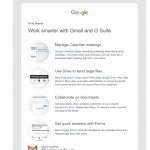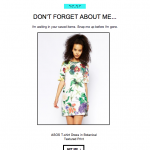How to Use Email Marketing to Build Customer Relationships
Email marketing can make or break your relationship with a potential customer. Get it right from the start, and you’re on the right track of the buyer’s journey with the customer. Get it wrong and you might alienate them entirely. Consider this; you open your inbox and find an email from a mattress company. Immediately, a flashing banner tells you to buy this super bouncy, king size mattress “NOW!”. You’d actually been thinking about a new mattress, which is why you opened the email – but the problem is, you were considering a firm, single mattress for about a quarter of the price… Plus, you had no intention of buying until next month. The company has taken no time to understand your needs and your current stage in the buying journey. They’re talking at you rather than to you.
As the consumer preference for email grows and 73% of millennials prefer communications from businesses to come via email, so does the customer’s expectation levels. Savvy consumers demand a dialogue with businesses; they demand a relationship in which the business understands their individual needs and preferences.
But where to start? And, as an SMB with a never-ending task list and an already hectic workforce, how can email marketing be used efficiently as well as effectively? That’s where marketing automation comes in.
Here Are 5 Tips That Will Help You Leverage Email Marketing for Long Term Customer Relationships
1. Keep it friendly and welcoming
They say you only get one chance to make a first impression – and the same can be said for email marketing. In fact, 320% more revenue is attributed to welcome emails than any other promotional email. Once you’ve acquired a prospect’s email address, it’s essential that you acknowledge and welcome them. Remember that the prospect is trusting you with their data and they’ve given you permission to contact them so reassure them that doing so was the right choice.
At this early stage of the journey, you’re unlikely to know a lot about the prospect – and vice versa – so don’t make assumptions and don’t try to force a sale upon them (in other words, don’t get ahead of yourself).
Take a look at this welcome email from Gmail:
What’s great about this welcome email is that it’s short and snappy, it’s relevant to the prospect’s current stage in the buying cycle, and it gives the prospect plenty of opportunities to click through by presenting lots of different features. This last strategy is particularly effective as, through the use of marketing automation software, you can identify which feature engaged the prospect (so you know it’s of interest to them) and consequently send more emails on that subject to them at a later date.
2. Give, don’t just take!
If you want to establish a genuine and long-standing relationship with a customer (and potentially secure future sales), it’s essential that every email is of value to the prospect and offers something of use. This doesn’t mean that you have to give a huge discount code in every email; it doesn’t even have to be of monetary value. Do you have useful content that could be shared? A whitepaper on your industry? Could you include a link to a free “How To” guide in your email? By demonstrating that you want to offer your prospects value, you’re far more likely to build trust and, consequently, establish a much stronger relationship in the long run.
3. Segment, segment… and then segment some more
One of the greatest features of marketing automation is the ability to create highly segmented data lists, which allow you to create highly personalized emails. Personalization can now go far beyond dropping the recipient’s name into a subject line, so be sure to harness all of the power of marketing automation to create emails that feel as if they’re written solely for one individual. The benefit of segmentation? Click-throughs are more than 100% higher in segmented emails versus non-segmented campaigns.
For example, let’s say you run a competition for a chance to win a specific product in your range. As a relevant follow-up to the competition, you could send all subscribers an email thanking them for participating and giving them an exclusive discount for the product that they were competing for. You already know they’re interested in that product and a discount that’s relevant to them might just be the thing that tips them over the line to purchase.
Take a look at this highly segmented email from online fashion retailer, ASOS;
Here, ASOS have used marketing automation to identify abandoned shopping cart products and then send a reminder about them to the shopper. The use of segmentation here is exceptional; this email might mean nothing to 99% of ASOS’ database – but to that one shopper who viewed this item, it couldn’t be more personal and relevant.
5. Remember; it’s a marathon, not a sprint
There can be a temptation to take a prospect through the buying journey as quickly as possible – but even the most effective closing email is unlikely to hook a prospect at the top of the funnel. They first need to be nurtured and develop their trust in your business. With this in mind, consider using marketing automation to create workflows that are aligned with the progress of your prospects, and let them determine the speed at which they encounter your emails.
5. Everyday’s a school day… learn the lessons!
Thanks to the in-depth analytics and reporting features of marketing automation, we no longer have to guess at what worked and what didn’t in our email campaigns. Be sure to use the data to your advantage, allowing it to determine your next move or campaign. For example, if a report highlights that a certain area of an email campaign was clicked significantly more than any other, you can leverage this insight to ensure you use a similar tactic in the future as you know it produces the right results.
Considering all of the above, it’s clear to see that a generic email blast simply won’t cut it. Every communication with your customer needs to steer them in the right direction on their buying journey to conversion and beyond. From your very first welcoming message to that all-important sale, your email marketing goal is to engage the target and provide them with information that’s exactly right for them at that time. Every email needs to relate to one another just as topics in a conversation would.
And that’s why strategic email marketing can be so effective for building relationships – especially for SMBs; whilst the communication channel might now be digital, it’s still ultimately a one-to-one dialogue in which a longstanding relationship can be built.
Read our latest articles:
Top 10 Must-Know Digital Marketing Tools




